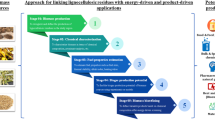Abstract
The object of this paper is to identify and assess the elements taken from agro-industries and fossil hydrocarbon refineries, especially with respect to biomass logistics, fractionation kinetics, and process energetics. Such critical information will be of immediate use by policy and decision makers, especially in the early phase of planning and designing the first generation of biorefineries. Concerning feedstock logistics, biorefineries have a lot to learn from food and wood supply chains. This learning could lead to the deployment of complex, decentralised, stage-wise biorefining systems, consisting of local agro-refineries, regional biorefineries, where the primary plant fractions are processed and upgraded to useful intermediates, and central bioconversion units for the generation of market-grade biofuels, such as biohydrogen and other high value-added vectors. The kinetic aspects of biorefineries are related to the physico-chemical nature of the macromolecules. Finally, to solve the problem of the non-optimal energy transformations a tailored-up bioenergy plan is proposed for each biorefinery. The example of a wheat bran-based biorefinery, aiming at the production of biohydrogen will be used to illustrate the way ahead.



Similar content being viewed by others
References
Avgerinos E, Billa E, Papatheofanous M, Koullas DP, Koukios EG (2004) Developing molecular strategies for the delignification and characterisation of annual plant fibres. C R Biol 327(9–10):927–933
Avgerinos E, Billa E, Koukios E.G. (2005) Correlating structural and functional properties of lignocellulosics and paper by fluorescence spectroscopy and chemometrics. In: Severian Dumitriu (ed) Polysaccharides: structural diversity and functional versatility, 2nd edn. Marcel Dekker, New York, pp 267–280
Dale BE (2004) Bioengineering of biomass. In: Encyclopedia of physical science and technology. Elsevier, Amsterdam, pp 141–157
Dien BS, Nguyen QA (2005) Biomass pretreatment and hydrolysis. Appl Biochem Biotechnol 124(1–3):885–888
Elliott DC (2004) Chemicals from biomass. In: Encyclopedia of energy. Elsevier, Amsterdam, pp 163–174
Gadalla M, Jobson M, Smith R (2003) Optimization of existing heat-integrated refinery distillation systems. Chem Eng Res Des 81:147
Gravitis J, Zandersons J, Vedernikov N, Kruma I, Ozols-Kalnins V (2004) Clustering of bio-products technologies for zero emissions and eco-efficiency. Ind Crops Prod 20:169–180
Koukios EG (1985) Biomass refining: a non-waste approach. In: Hall DO et al (eds) Economics of ecosystem management. Dr. W. Junk Publishers, Dordrecht, pp 233–244
Koukios EG (1987) The effects of new biosystems technology on land use—the case of the European Community. Land Use Policy 4(3):219–228
Koukios EG (2002) Biomass. The future of renewable energy, vol 2. EUREC Agency, James & James, London, pp 1–24
Koukios EG, Sidiras DK (1995) The role of prehydrolysis in refining lignocellulosic biomass. Cellulose Chem Technol 29(4):435–450
Munck L (2004) Whole plant utilization. In: Encyclopedia of grain science. Elsevier, Amsterdam, pp 459–466
Özkan S, Dinçer S (2001) Application for pinch design of heat exchanger networks by use of a computer code employing an improved problem algorithm table. Energy Convers Manag 42:2043–2051
Papatheofanous MG, Koullas DP, Koukios EG, Fuglsang H, Schade JR, Loefkvist B (1995) Biorefining of agricultural crops and residues: effect of pilot-plant fractionation on fibrous fraction properties. Biomass Bioenergy 8(6):419–426
Sidiras D, Koukios EG (2004) Simulation of acid catalysed organosolv fractionation of wheat straw. Bioresour Technol 94(1):91–98
Georgopoulos STh, Tarantili PA, Avgerinos E, Andreopoulos AG, Koukios EG (2005) Thermoplastic polymers reinforced with fibrous agricultural residues. Polym Degrad Stab 90:303–312
Xiang Q, Lee YY, Torget RW (2007) Kinetics of glucose decomposition during dilute-acid hydrolysis of lignocellulosic biomass. Appl Biochem Biotechnol 115(1–3):1127–1138
Acknowledgments
The support of the research reported here by the European Union’s fifth Framework Programme, Directorate-General for Research, in the frame of the HYVOLUTION Integrated Project, through Contract 019825, is gratefully acknowledged by the authors. This paper represents original work which has not been published in any of SV journals with the exception of a short version in PRES2008 proceeding.
Author information
Authors and Affiliations
Corresponding author
Rights and permissions
About this article
Cite this article
Koukios, E., Koullas, D., Koukios, I.D. et al. Critical parameters for optimal biomass refineries: the case of biohydrogen. Clean Techn Environ Policy 12, 147–151 (2010). https://doi.org/10.1007/s10098-009-0239-y
Received:
Accepted:
Published:
Issue Date:
DOI: https://doi.org/10.1007/s10098-009-0239-y




